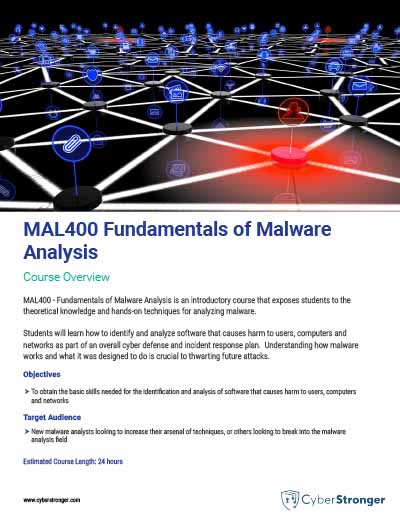Overview
MAL400 – Fundamentals of Malware Analysis is an introductory course that exposes students to the theoretical knowledge and hands-on techniques for analyzing malware.
Students will learn how to identify and analyze software that causes harm to users, computers and networks as part of an overall cyber defense and incident response plan. Understanding how malware works and what it was designed to do is crucial to thwarting future attacks.
Target Audience
New malware analysts looking to increase their arsenal of techniques, or others looking to break into the malware analysis field.
Objective
To obtain the basic skills needed for the identification and analysis of software that causes harm to users, computers and networks.
Topics
Introduction to the overall malware analysis process and methodology. Students define terminology, learn specific malware types and cover fundamental approaches of analysis, in addition to learning how to effectively analyze program code/structure to determine function. Students are challenged with three labs. Day 1 ends with a detailed overview of setting up and using a safe virtual environment for malware analysis.
Day 2 focuses on easy-to-use techniques to dynamically analyze malicious programs by running them in a lab. Students learn to observe true behavior of malware and determine its purpose and functionality via live demos and three challenging specimens they must analyze. Day 2 centers around how malware interacts with the victim’s OS by looking at network activity, registry changes and interactions with the file system.
Day 3 closes behavioral analysis and ends with a final fourth lab. Students then begin X86 assembly language. This module is crucial for learning follow-on analysis techniques using debuggers and disassemblers. Students learn key concepts in assembly language to assist follow-on analysis with IDA Pro. IDA Pro is introduced as a disassembler and reverse engineering tool. Considerable time is spent on familiarization with the UI and IDA’s numerous features. Plenty of code snippets, demos and two IDA familiarization labs help the student understand both assembly language and how to use IDA Pro.
IDA Pro Introductions continues on Day 4 with the identification and analysis of more complex functions. Students are gradually exposed to more complex malware and its disassembly to build confidence and skills. Students learn techniques needed to identify, categorize and analyze high-level functionality of assembly code. Two labs challenge students to identify a variety of C code constructs in malware specimens as part of an overarching analysis strategy.
Students spend their final day analyzing two malicious programs to further solidify analysis skills focusing on the identification of C code constructs in assembly, and how these high-level constructs correlate to other aspects of the program and its behavior. An instructor-led review of all major topics will be conducted and any final questions will be answered. After the course, students have 90 days to challenge the optional CYBRScore-enabled certification associated with MAL400. The certification presents a malware specimen to the challenger that must be analyzed using the techniques and tools learned in this course. Our behind-the-scenes scoring engine will track progress throughout against a rubric of core skills that must be demonstrated in the hands-on analysis.
